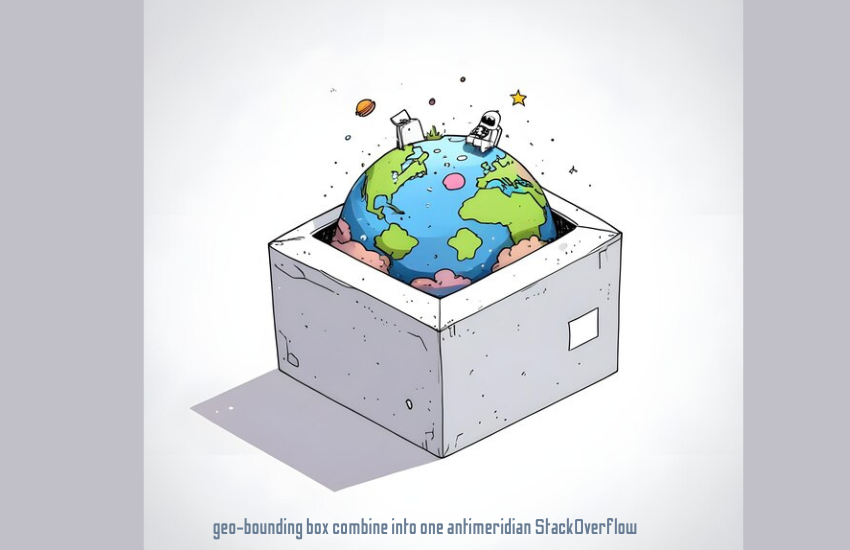Geo-bounding box combine into one antimeridian StackOverflow is a rectangular area defined by its northern, southern, eastern, and western boundaries in geographical coordinates (latitude and longitude). These boxes are widely used in mapping applications to specify areas of interest, simplify spatial queries, and optimize geographic data processing.
Importance of Geo-Bounding Boxes in Mapping and GIS
Geo-bounding boxes are crucial because they simplify the representation and querying of spatial data. By reducing complex geographic features to a simple rectangular area, they enable more efficient spatial indexing and searching, which are fundamental in large-scale mapping applications and services.
Understanding the Antimeridian
The antimeridian is an imaginary line of longitude that is exactly opposite the Prime Meridian (0 degrees longitude), located at 180 degrees east or west. It plays a unique role in geography because it acts as a “line of change,” separating two consecutive calendar days.
Challenges with the Antimeridian in Mapping
Handling the antimeridian can be tricky because it splits the Earth into two hemispheres where coordinates jump from positive to negative values suddenly (or vice versa). This can disrupt conventional geographic operations like bounding box calculations, which assume continuity.
Common Issues with Geo-Bounding Boxes
When a geo-bounding box crosses the antimeridian, its representation becomes ambiguous. Standard bounding box definitions do not account for this split, resulting in incorrect area calculations or errors in spatial queries.
Problems with Geo-Bounding Boxes Crossing the Antimeridian
The main problem is that traditional bounding boxes are not designed to handle splits caused by the antimeridian. For instance, a box extending from 170 degrees east to -170 degrees west technically encompasses 20 degrees of longitude, but traditional systems might incorrectly interpret it as spanning almost the entire globe.
Effects on Data Representation
Incorrect bounding box calculations can lead to misrepresentations of data, which can cause inaccuracies in map visualizations and analytical results. This is particularly problematic in applications like navigation, weather forecasting, and global asset tracking.

Combining Geo-Bounding Boxes
To overcome issues with the antimeridian, it is often necessary to combine geo-bounding boxes in a way that respects their geographic boundaries.
Why Combine Geo-Bounding Boxes?
Combining bounding boxes can simplify data management by reducing the number of discrete areas to consider, particularly in global datasets that span large geographic extents.
Methods for Combining Geo-Bounding Boxes
Several methods exist for combining geo-bounding boxes, such as expanding one box to encompass another, merging overlapping boxes, or creating a minimal enclosing box that covers all specified boxes. However, when dealing with the antimeridian, these methods must be adapted to handle the split appropriately.
Antimeridian Split in Geo-Bounding Boxes
Issues with Geo-Bounding Boxes at the Antimeridian
Bounding boxes that span the antimeridian can be misinterpreted by many mapping systems because they expect the western boundary to always be less than the eastern boundary. The antimeridian defies this logic, leading to errors.
How Splits Occur and Their Impact
Splits occur when the eastern boundary of a bounding box is east of the antimeridian, and the western boundary is west of it, creating a scenario where the box technically encompasses a narrow strip across the 180-degree line but is perceived as a full-circle wrap-around.
Techniques for Handling the Antimeridian
Approaches to Manage Antimeridian Crossings
One common technique is to split the bounding box into two separate boxes, one on each side of the antimeridian, then handle them individually. Another approach is to adjust the longitude values such that the box is correctly interpreted across the antimeridian.
Adjusting Geo-Bounding Boxes Across the Antimeridian
Adjusting bounding boxes involves modifying the coordinates so that the box remains logically continuous across the antimeridian. This can involve reinterpreting the coordinates or shifting them into a normalized space.
Combining Boxes Across the Antimeridian
Step-by-Step Guide to Combine Geo-Bounding Boxes Across the Antimeridian
- Identify the Split: Determine if the bounding box crosses the antimeridian by checking if the west boundary is greater than the east boundary.
- Split and Recombine: If a split is detected, divide the bounding box into two—one on each side of the antimeridian.
- Normalize Boundaries: Adjust the coordinates of the bounding boxes to ensure correct representation, possibly shifting values so the longitude wraps appropriately.
- Merge and Simplify: Combine the normalized boxes into a single, logical bounding box.
Using Python for Combining Geo-Bounding Boxes
Python offers powerful libraries like Shapely and GeoPandas, which can simplify the manipulation of geographic shapes and the combining of geo-bounding boxes.
Python Libraries and Tools
- Shapely: For geometric operations on coordinates.
- GeoPandas: To work with geographic data in a Pandas-like interface.
- Cartopy: Useful for projections and handling geographic transformations.
GeoJSON is a widely used format for encoding geographic data. However, handling the antimeridian in GeoJSON can be problematic due to its adherence to straightforward bounding boxes.
How GeoJSON Handles the Antimeridian
GeoJSON defines bounding boxes with min and max values for coordinates. For boxes crossing the antimeridian, this can lead to incorrect representations unless adjusted manually.
Best Practices for GeoJSON and Antimeridian Issues
- Split Polygons: Divide complex polygons at the antimeridian.
- Normalize Coordinates: Adjust coordinates to ensure correct interpretation.
- Use Multipolygons: For areas crossing the antimeridian, use multipolygon features to keep data accurate.
Common Pitfalls and How to Avoid Them
Typical Errors in Antimeridian Handling
- Misinterpreting bounding box spans.
- Incorrectly combining boxes that span large areas.
- Overlaps not correctly managed due to wrap-around effects.
Troubleshooting Tips and Best Practices
- Always verify bounding box integrity when dealing with global data.
- Utilize libraries that support antimeridian crossings explicitly.
- Test visual outputs in GIS tools to confirm correct representation.
Advanced Techniques and Algorithms
For more complex bounding box combinations, consider advanced algorithms that employ spatial indexing, divide-and-conquer approaches, and geometrical transformations to accurately merge geo-bounding boxes.
Advanced Algorithms for Bounding Box Combination
- R-tree indexing: For efficient spatial searching and merging.
- Convex hull calculations: To form minimal enclosing shapes.
Using Spatial Indexing and Geometrical Calculations
Combining bounding boxes efficiently at scale can be significantly optimized using spatial indexing methods like R-trees, which allow for quick lookups and merges of geographic data.
Working with GIS Tools
Several GIS tools can assist in managing geo-bounding boxes, including QGIS, ArcGIS, and online platforms like Google Earth Engine.
GIS Tools for Managing Bounding Boxes
- QGIS: An open-source tool with robust support for antimeridian handling.
- ArcGIS: Offers advanced geospatial analytics and antimeridian-aware functions.
- Google Earth Engine: For large-scale data analysis with built-in antimeridian support.
Software Recommendations and How to Use Them
- Use QGIS plugins for advanced bounding box manipulation.
- ArcGIS Pro for professional-grade geographic data management.

Case Studies and Real-World Examples
Examining real-world applications of antimeridian handling can provide insights into practical approaches and common challenges.
Real-World Applications and Case Studies
- Shipping Routes: Managing routes that cross the Pacific Ocean.
- Satellite Tracking: Handling global orbits that cross the antimeridian.
- Weather Prediction Models: Encompassing large-scale data around the globe.
Lessons Learned from Antimeridian Handling
- The importance of accuracy and consistency in data representation.
- Strategies to avoid pitfalls in global data management.
FAQs on Geo-Bounding Boxes and the Antimeridian
- What is a geo-bounding box?
- A geo-bounding box is a rectangular boundary defined by geographical coordinates that encompass a particular area of interest on a map.
- Why does the antimeridian cause problems in geo-bounding boxes?
- The antimeridian causes problems because it splits the globe into two, which can confuse traditional box definitions that assume continuity without a break.
- How can I combine geo-bounding boxes across the antimeridian?
- You can combine them by splitting at the antimeridian, normalizing coordinates, and merging the split boxes with appropriate GIS or coding techniques.
- What tools can help with managing antimeridian splits?
- Tools like QGIS, ArcGIS, and Python libraries such as Shapely and GeoPandas are effective for managing these splits.
- Can GeoJSON handle antimeridian crossing bounding boxes?
- GeoJSON can handle them, but it requires manual adjustments or the use of multipolygon features to correctly represent the data.
- Are there any best practices for dealing with antimeridian splits?
- Best practices include using spatial indexing, verifying data visually, and applying advanced algorithms for precise bounding box manipulation.
Conclusion
Handling geo-bounding boxes that cross the antimeridian requires careful consideration of geographic principles and appropriate use of technology. By employing the right tools and techniques, these challenges can be managed effectively, ensuring accurate and efficient data representation in mapping and GIS applications.


